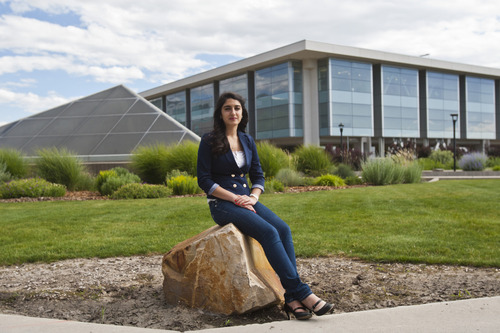This is an archived article that was published on sltrib.com in 2013, and information in the article may be outdated. It is provided only for personal research purposes and may not be reprinted.
Washington • Satin Tashnizi has already had to compromise on her future. Financial obstacles have chipped away at the 18-year-old's dream, and unless Congress takes action in the next week to prevent a big jump in student loan interest rates, it may just crumble altogether.
Since Tashnizi, a Salt Lake City resident, turned 14, she's wanted to be a heart surgeon and set her sights on studying at the University of Massachusetts Amherst.
She received an acceptance letter last year but quickly realized she couldn't afford the extra $20,000 annually in out-of-state tuition, even with a combination of federal grants and loans.
Tashnizi's dream school was destined to remain just that — a dream. She started classes at the University of Utah in January.
"Even now that I'm in state, I'm still really, really struggling to pay for school," said Tashnizi, who was surprised her loans, some federally subsidized, and her Pell Grants, a needs-based award, didn't stretch further.
The buying power of those student loans will shrink even more if Congress doesn't act in the next few days. On Monday, a federal law keeping interest rates on subsidized loans at a low 3.4 percent will expire and the rate will vault to 6.8 percent. That's where it stood in 2007 when President George W. Bush signed a bill meant to make college more affordable.
President Barack Obama and Congress already extended the artificially low rates once, and both political parties agree that they need to take action again, but differ as to what that should be. The president and Republican leaders want to tie the student loan rates to Treasury bond rates, which would allow loan rates to move up and down with the market. But they differ on what should happen after students take out a loan.
—
Fixed vs. variable • Obama wants students to have the security of one rate locked in for the life of the loan. Republicans want the rate to adjust yearly to stay current with the market. The Senate is trying to negotiate a middle position.
When the House passed its bill, Utah's four representatives voted along party lines. Republicans Rob Bishop, Jason Chaffetz and Chris Stewart backed the majority plan, which capped the moving rate at 8.5 percent. Rep. Jim Matheson, a Democrat, opposed that.
"I just think this is a great solution," Stewart said of the GOP bill. "It takes the government out of the wallets of students and those who have student loans."
The freshman congressman has one son in medical school and another who recently graduated from law school, and he said he sympathizes with those who find themselves saddled with "enormous student debt." The GOP plan, he said, "would help eliminate some of the pressures on that." He doubts the interest rate will approach the 8.5 percent cap.
"I think generally the student loan rates will go much lower than, certainly lower than what's going to happen if the Senate doesn't act," he said.
Stewart isn't confident that Congress will act before the deadline — inaction that would result in the 6.8 percent rate.
Sen. Orrin Hatch, R-Utah, blames the stalemate on Democrats, arguing there is a middle ground that is "fair to students."
"This is just another example of the White House playing politics," he said, "instead of working with Republicans to enact good legislation."
Senate negotiators, in consultation with the White House, are approaching a deal that would set different rates for undergraduates and graduates.
If those talks fail and nothing gets done, Bishop could live with it.
—
Not Congress' job • A former high school teacher, Bishop supported the House student-loan bill because he said it was the best option on the table, but he believes government should get out of the business of student loans altogether.
"This is simply not our responsibility," he said. "We don't handle it well."
Bishop said student loans should be the responsibility of private companies or, if government is involved, they should be handled at the state level.
"The idea that the federal government should step in here is frightening."
Matheson couldn't disagree more. He believes federal policy properly works to "level that playing field so there's not an insurmountable financial hurdle to go on and get additional education." That means offering federal grants and student loans.
He resists the idea of variable-rate loans and worries about setting a rate too far above that of a 10-year Treasury bond.
"We want people to look for the jobs that they want to do and are passionate about," he said. "We don't want economics to necessarily be driving their decisions."
Nearly 58,000 Utah students received a federally subsidized loan in the 2011-12 academic year, and graduates finished school with an average of $17,200 in debt, according to the Utah System of Higher Education. That's significantly lower than the national average of $26,700, in part because the state's universities and colleges are cheaper and many Utah students work while going to school.
Tashnizi has a paid internship along with her job at Ann Taylor, which pay for her rent and groceries. She shared her personal story with Matheson, who met with a group of Utah students to discuss college costs.
He mentioned a few of them on the House floor to remind Congress of the real-world impacts of the debate.
"This legislative process sometimes becomes more theoretical and not real," he said. "Sometimes I think it's too easy for members of Congress to forget how important this is to specific individual people and their world."
—
Utahn's story • Tashnizi's story stood out to Matheson because, as first-generation Americans, her family has always considered educational opportunity to be part of the American Dream.
Satin grew up watching both of her parents struggle to provide for her, working multiple jobs while going to school, continually reminding Satin that America is the land of opportunity," he said in a speech on the House floor in mid-June.
Tashnizi's mother emigrated from Iran in 1993 and went to college and graduate school while her daughter was in elementary school. She instilled in Tashnizi the conviction that a good education could take her anywhere she wanted to go.
"Every single morning that I woke up she would say, 'Satin, you can do whatever you want, just get your education,'" Tashnizi said. It never occurred to her that money may stand in her way.
Sitting cross-legged on her living room floor in September with Amherst paperwork around her, Tashnizi watched Obama accept his party's nomination at the Democratic National Convention.
In his speech, he said: "No family should have to set aside a college acceptance letter because they don't have the money."
Tashnizi, teary-eyed, realized she would have to do just that.
"I felt someone turned a back on me when I had tried so hard, worked so hard to show myself," she said.
Today, she's concerned that such a decision may lie before her once again.
If increased interest rates make the debt from her undergraduate degree unmanageable, she may have to think twice about becoming a heart surgeon.
"I don't want my reasons for diverting from medical school to be anywhere related to money," she said.
Bishop fears student loan rates kept artificially low by government encourages young people to get into more debt than they can handle.
But Tashnizi thinks making education affordable should be a top priority for lawmakers.
"Given the state of the economy," she said, "I don't think it's wrong to ask the government for a helping hand in this situation."
Taking a stand on student loans
The president's position • President Barack Obama wants to set the interest rate for federally backed student loans at a little less than 1 percentage point above the rate charged for 10-year Treasury notes. He wouldn't place a cap on how high the interest rate could go, but would lock in the rate for the life of the loan.
The House bill • The House-passed measure would set the interest rate on all Stafford loans at the rate of high-yield 10-year Treasury notes plus 2.5 percent. That would put the current rate at around 5 percent. Tied to the market, the amount of interest students pay would move up and down annually, but would be capped at 8.5 percent.
The Senate's plan • A bipartisan Senate coalition has put forward a plan meant to bridge the gap. It offers different rates for undergraduate, graduate and PLUS loans, with undergraduates getting the lowest rates. All rates would be tied to the interest rate of a high-yield 10-year Treasury note and locked in for the life of the loan. Based on current Treasury note rates, all of the loan rates would be lower than the 6.8 percent that would kick in without action.









